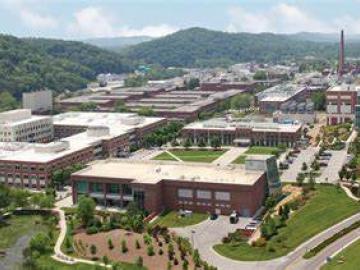Filter News
Area of Research
- Advanced Manufacturing (10)
- Biological Systems (1)
- Biology and Environment (48)
- Clean Energy (83)
- Computer Science (1)
- Fuel Cycle Science and Technology (1)
- Fusion and Fission (32)
- Fusion Energy (5)
- Isotope Development and Production (1)
- Isotopes (5)
- Materials (98)
- Materials Characterization (1)
- Materials for Computing (11)
- Materials Under Extremes (1)
- National Security (13)
- Neutron Science (38)
- Nuclear Science and Technology (25)
- Quantum information Science (1)
- Supercomputing (58)
News Type
News Topics
- (-) 3-D Printing/Advanced Manufacturing (76)
- (-) Bioenergy (70)
- (-) Composites (14)
- (-) Frontier (33)
- (-) Materials Science (85)
- (-) Nuclear Energy (74)
- (-) Physics (49)
- Advanced Reactors (16)
- Artificial Intelligence (65)
- Big Data (28)
- Biology (75)
- Biomedical (43)
- Biotechnology (16)
- Buildings (28)
- Chemical Sciences (45)
- Clean Water (15)
- Climate Change (65)
- Computer Science (132)
- Coronavirus (34)
- Critical Materials (11)
- Cybersecurity (31)
- Decarbonization (56)
- Education (3)
- Element Discovery (1)
- Emergency (1)
- Energy Storage (68)
- Environment (132)
- Exascale Computing (30)
- Fossil Energy (4)
- Fusion (40)
- Grid (35)
- High-Performance Computing (63)
- Hydropower (5)
- Isotopes (39)
- ITER (4)
- Machine Learning (31)
- Materials (94)
- Mathematics (5)
- Mercury (9)
- Microelectronics (2)
- Microscopy (35)
- Molten Salt (3)
- Nanotechnology (42)
- National Security (46)
- Net Zero (9)
- Neutron Science (92)
- Partnerships (36)
- Polymers (19)
- Quantum Computing (23)
- Quantum Science (50)
- Renewable Energy (2)
- Security (21)
- Simulation (31)
- Software (1)
- Space Exploration (14)
- Statistics (1)
- Summit (49)
- Sustainable Energy (67)
- Transformational Challenge Reactor (7)
- Transportation (50)
Media Contacts

Rishi Pillai and his research team from ORNL will receive a Best Paper award from the American Society of Mechanical Engineers International Gas Turbine Institute in June at the Turbo Expo 2024 in London.

ORNL’s Erin Webb is co-leading a new Circular Bioeconomy Systems Convergent Research Initiative focused on advancing production and use of renewable carbon from Tennessee to meet societal needs.

A first-ever dataset bridging molecular information about the poplar tree microbiome to ecosystem-level processes has been released by a team of DOE scientists led by ORNL. The project aims to inform research regarding how natural systems function, their vulnerability to a changing climate and ultimately how plants might be engineered for better performance as sources of bioenergy and natural carbon storage.

Scientists at ORNL have developed 3D-printed collimator techniques that can be used to custom design collimators that better filter out noise during different types of neutron scattering experiments
ORNL scientists have determined how to avoid costly and potentially irreparable damage to large metallic parts fabricated through additive manufacturing, also known as 3D printing, that is caused by residual stress in the material.
The United States could triple its current bioeconomy by producing more than 1 billion tons per year of plant-based biomass for renewable fuels, while meeting projected demands for food, feed, fiber, conventional forest products and exports, according to the DOE’s latest Billion-Ton Report led by ORNL.

Three staff members in ORNL’s Fusion and Fission Energy and Science Directorate have moved into newly established roles facilitating communication and program management with sponsors of the directorate’s Nuclear Energy and Fuel Cycle Division.

In a win for chemistry, inventors at ORNL have designed a closed-loop path for synthesizing an exceptionally tough carbon-fiber-reinforced polymer, or CFRP, and later recovering all of its starting materials.

New computational framework speeds discovery of fungal metabolites, key to plant health and used in drug therapies and for other uses.

Corning uses neutron scattering to study the stability of different types of glass. Recently, researchers for the company have found that understanding the stability of the rings of atoms in glass materials can help predict the performance of glass products.




